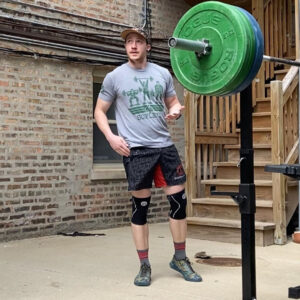Note: This post originally appeared on the South Loop Strength & Conditioning blog.
At South Loop Strength & Conditioning, we have regular coaches’ meetings.
During these meetings, in addition to the standard boring business stuff about new protocols and pending equipment orders, we also spend a lot of time on continuing education.
The prescriptions that we give our clients and our athletes require a subtle understanding of training goals to prescribe correctly – and to coach correctly.
So, we want to ensure that all of our coaches are on the same page in terms of, not just understanding the moment-to-moment of coaching good movement, but also the higher order thinking that goes into designing a training session to get a specific dose response as well as the progression of sessions over the course of a training cycle.
Since a lot of valuable information-sharing and discussion goes on in these meetings, we figured that we’d start sharing some of that with the world.
At one of our meetings earlier this month, we went through a discussion on how to prescribe training for the CP Battery – and how to correctly coach this in both an individual and a group class setting.
A rough explanation of the CP battery is that it is the ability to restore the creatine phosphate pathway (think heavy squats, fast sprints, high jumps, etc.) in order to repeat high percentage efforts.
This capacity is very relevant for people wishing to compete in fitness as a sport (think “heavy” metcons or gymnastics bottlenecks) as well as those looking to compete in repeated sprint sports like soccer or rugby (Check out this paper on repeated sprint athletes.
This video goes pretty deep in some technical aspects of program design, so, if you’re into that, I hope you find this very valuable and you get some good insight from it.
Take a look here for some of the notes from the video.
I wanted to put some of the content from the whiteboard right here so that you guys can see some of the concepts written out easily.
Testing the CP battery
This is a classic CP battery test for fitness athletes courtesy of James FitzGerald and Max El-Hag.
8 min to find a max power clean for today
+
Rest 2 min
+
8 min AMRAP:
Power cleans @ 90% of today’s max (don’t use all time personal best)
*For Regional level fitness athletes, you will often see a relatively “high” power clean (~300 pounds for males and ~ 200 pounds for females) and 30+ reps at 90%.
*Top level fitness athletes will start to approach 40 reps in 8 min while also having a “high” power clean.
*For beginners, this test is misleading since they don’t have a “true” 1RM power clean based upon either technical issues or based upon total CNS recruitment in the movement pattern.
Training the CP battery: Every minute on the minute
A common way to train the CP battery is through “every minute on the minute” sessions.
We crowd-sourced an EMOTM session for a mid-tier fitness athlete that looked something like this:
EMOTM 20:
1st min: 5 front squats @ 60-75% of 1RM
2nd min: 4-7 kipping handstand push-ups to deficit – tough
3rd min: 3-5 strict chest-to-bar pull-ups – add weight if possible
4th min: 10s airdyne @ 100%
The ranges of percentages and reps allows an athlete in a group training environment to find the right prescription for them. Based upon an individual’s capacity in battery work as well as their tendency towards being either explosive or enduring, the relative weight that they’re going to be able to use in barbell movements relative to their 1RM is going to be very different.
For the gymnastics movements, giving the athlete a rep range and also allowing an athlete to adjust the deficit on the handstand push-up or the weight on the chest-to-bar pull-up gives them room to find the right degree of difficulty for them relative to their capacity.
We also discussed using watts or rpm to track output on the airdyne, since that is much more sensitive relative to the timeframe of 10s than something like calories or distance.
Training the CP battery: “Grinders”
We also crowd-sourced a grinder chipper as another way to train CP battery for fitness athletes.
The workout we came up with was the following:
For time:
10 clean & jerks @ 55-65%
30 wall balls (20/14)
30 KB swings (55/35)
10 muscle-ups
30 box jumps, step down (24/20)
30 airdyne calories
10 wall climbs
The idea behind this workout is that we have “road block” movements in the heavy-ish clean & jerks, the muscle-ups and the wall climbs that force pacing on the rest of the workout. If someone were to go at an all out pace on the wall balls, KB swings, box jumps and airdyne, they would significantly impede their performance on the muscle-ups and wall climbs. So, this type of training session forces pacing and keeps people from going to far past redline, since they intuitively understand that they have to keep their output a bit lower when they have a road block coming up.
Common pitfalls when training the CP battery
When designing this type of training or coaching it, there are a lot of common pitfalls that come up.
*Many people pace this incorrectly – either by not finding something that’s hard enough relative to their capacity or by going too hard and falling apart. When doing an EMOTM session, for example, the output should be consistent each minute – or at least within the prescribed rep range. If it’s not, the athlete may have selected something that is too difficult, or gone at too hard of a pace on their first few rounds.
*Consider the total volume of a training session. I often use 5 minute AMRAPs as CP battery benchmarks for people. 5 min AMRAP of handstand push-ups, strict chest-to-bar pull-ups, muscle-ups, deadlifts (315/205), etc. Based upon these numbers, I will try to prescribe a battery session that has volume not too far from the total reps that an athlete was able to complete in a 5 minute AMRAP.
*Don’t be afraid to manipulate rest periods or work periods. If someone is having a hard time on an EMOTM session, it’s perfectly acceptable to either increase their rest so that they’re doing work every 90s, or to decrease their work time from, say, 10s on the airdyne to 6s. This is more about getting the correct dose response than completing a workout as written.
I also want to apologize to you guys for some of the questions and responses that you can’t hear. We ran this like a normal coaches’ meeting without fully taking into account that it would be posted online for viewing consumption. In the future, when we do this type of video, we will do a better job of making sure that we either mic the audience or repeat the questions.
Ask any questions you have on this stuff in the comments as well. I know there can be some subtlety and confusing points here, so let me know and I will do my best to clarify anything that isn’t fully explained.





